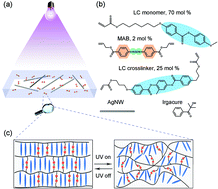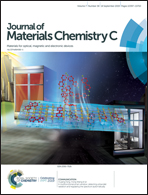Multidirectional biomimetic deformation of microchannel programmed metal nanowire liquid crystal networks†
Abstract
A facile, microchannel-based method is shown to induce arrangement of liquid crystal molecules, programming alignment patterns into azobenzene liquid-crystalline dynamic networks doped with silver nanowires (AgNW-AZO/LCN). AgNW-AZO/LCN was obtained by a UV curing reaction via mixing AgNWs with commercially available LC monomer, crosslinker and azobenzene (MAB). The main-chain MAB can be covalently bonded to LCN, and cooperates with AgNWs to enhance the photothermal conversion efficiency, thereby improving the optical control driving the performance of actuators. However, it remains a challenge to fabricate biomimetic actuators that can convert external stimuli into complex behavior by mimicking natural intelligence. In the present work, by employing three types of microchannels, we demonstrate three kinds of actuators, corresponding to radial, annular and leaf-like microchannels, respectively. These actuators, combined with the precise control over molecular pre-definition, geometric structure and complex deformation, are expected to break through the limitations of current smart biomimetic systems, enabling simple and efficient fabrication of an intelligent large-scale robot.



 Please wait while we load your content...
Please wait while we load your content...